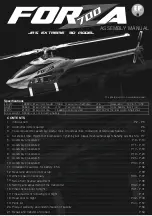
P.4
● In order to protect your feet, wear solid, easy-to-move shoes, avoiding sandals or high-heel shoes.
● Wear a cap, gloves, sunglasses or goggles as required.
③ Do not fly the Helicopter in an unnatural posture.
● Avoid standing in an unstable or slippery position.
● Do not fly while looking backward, sitting or lying.
● Do not bring the helicopter too close to the operator or surrounding people (if there are bystanders, make sure that
they are behind the operator).
④ Take sufficient flight breaks.
● An excessively long flight makes the operator lose his/her concentration due to fatigue, leading to accidents.
Take adequate flight breaks. Avoid an unreasonably long flight, which could result in unexpected accidents or
injuries.
① Make sure the bolts for the blades (main rotor, tail rotor) are properly tightened - there should be some movement possible.
Check all other screws to confirm they are properly tightened. Retighten any loose screws.
② Make sure that no tool used for assembly or adjustment has been left in the helicopter body, and that all parts
affecting flight performance are free from fault.
③ Keep the airfield as neat and tidy as possible and place the helicopter in a stable place (objects such as cables, wires, strings,
debris of broken parts, screws, etc., may be scattered by the wind pressure from the rotor and damage the helicopter).
④ Make sure that the batteries in the transmitter and the receiver are fully charged.
⑤ Always turn on the transmitter first.
⑥ Conduct a distance (range) test of the transmitter. Follow the directions of your transmitter manufacture.
Move the controls and confirm movement of the helicopter servos. If they do not move properly, check the cause and
have it repaired, if necessary.
⑦ a. Extend the transmitter's antenna to its full length. Put the receiver's antenna through an antenna tube and make sure that
it can easily receive the radio signal, ensuring it cannot be caught by moving parts (do not bend or bundle the antenna).
b. When using a 2.4GHz transmitter, please adjust the antenna as directed in the manual supplied with the transmitter.
◎ Starting
① When moving to a take-off site, note that if your clothes contact the transmitter sticks, the rotor may suddenly start
running. Please proceed with caution.
② When starting the motor, make sure that there is no person, animal or obstacle around the helicopter, which may be caught by the rotors.
③ After starting the motor, please understand setting the throttle stick / trim to slowest position stops the motor. Rising
the rotation speed suddenly is very dangerous. Start the rotation gradually using the slow start function of the ESC.
After the main rotor is rotating, abrupt stick operation will cause the helicopter to rise quickly. Please set the stick to
medium-slow position and wait. Make sure the rise of the rotor speed follows your stick operation.
④ When lifting the helicopter into the air, be sure to remain at least 10m or more away from it.
⑤ Land before adjusting the transmitter or helicopter. Do not allow part of your body or clothes to contact the
transmitter sticks by mistake, and do not put the transmitter down in a standing position because wind, etc. may tip
the transmitter over, bumping the throttle stick, and causing the helicopter to suddenly leap into the air, endangering
yourself or others.
⑥ Do not put your hand or any objects into the movable parts while they are running.
⑦ When checking the tracking adjustment stay at least 5m or more from the helicopter.
◎ Stopping
Move the throttle stick down and allow the motor and main rotor blades to stop completely. Hold the rotor head by hand,
remove the power-supply batteries, and switch off the receiver. Turn the transmitter off last.
Precautions for starting



















